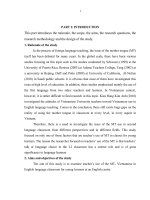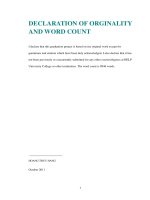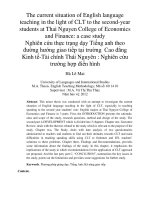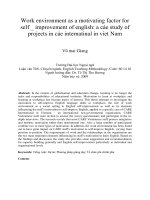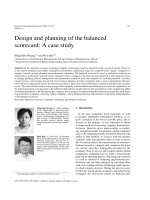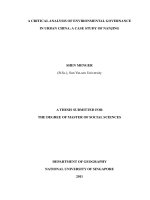A critical analysis of environmental governance in urban china a case study of nanjing
Bạn đang xem bản rút gọn của tài liệu. Xem và tải ngay bản đầy đủ của tài liệu tại đây (1.35 MB, 150 trang )
A CRITICAL ANALYSIS OF ENVIRONMENTAL GOVERNANCE
IN URBAN CHINA: A CASE STUDY OF NANJING
SHEN MENGER
(B.Sc.), Sun Yat-sen University
A THESIS SUBMITTED FOR
THE DEGREE OF MASTER OF SOCIAL SCIENCES
DEPARTMENT OF GEOGRAPHY
NATIONAL UNIVERSITY OF SINGAPORE
2011
ii
Acknowledgements
It has been a unique experience and great privilege to live and study in Singapore.
Studying in NUS has been an unforgettable learning experience I will always cherish
in my whole life. I deeply believe writing the thesis is a fascinating, humbling journey
and thinking about how everything has all come together to culminate in this piece of
work; and this study could not have been done without the support and assistance of
many people in the last two years during my master candidature. For the moment, I
am glad to have the opportunity to express my deep gratitude to all of them.
First of all, I would like to extend my deepest thanks to Dr. Pow Choon-Piew for his
patience, kindness, sense of humor, encouragement and your faith in me. You are a
wonderful mentor and I could not achieve this without you so THANK YOU!
Secondly, I would like to say thank you to my friends in NUS who have kept my
spirits up and have offered me advice, friendship and the occasional kick in the pants,
in particular: Cao Qian, Chen Rui, Chen Yanhong, Chew Kuoting, Fang Tianxiao, Li
Wenhui, Liu Yi and Zhao Zhenwei. I also appreciate the input from Erica Yap and
Ansley Rubinstein who have provided their editing assistance for this thesis.
Finally, this thesis is dedicated to my family: to my lovely cousins Li Xinchen and
Wang Yiran for their efforts extended to the fieldwork of this study; and to my parents
and grandparents for their unconditional love and unwavering support.
iii
Table of Contents
Acknowledgements ii
Summary v
List of Tables vii
List of Figures vii
Chapter 1 – Introduction 1
1.1 Background and Context of the Study 1
1.2 Study Objectives and Research Questions 7
1.2.1 Study Objectives 7
1.2.2 Research Questions 8
1.3 Research Methods 9
1.4 Overview of the Thesis 10
Chapter 2 – Conceptual Framework 14
2.1 Ecological Modernization 15
2.1.1 Literature Review on Ecological Modernization Theory 15
2.1.2 Social Environmentalism 18
2.1.3 Social Environmentalism in China 21
2.2 Governance Theory 24
2.2.1 Defining Governance 24
2.2.2 Environmental Governance and Its Relevance in the Thesis 33
Chapter 3 – Contested Environmental Governance Regimes in Nanjing 44
3.1 Introduction 44
3.2 Contested Horizontal Cooperation Regime among Government Agencies in Nanjing .49
3.3 Contested Vertical Accountability Regime among Government Agencies in Nanjing 54
3.4 Greening Environmental Governance Regimes in Nanjing 58
Chapter 4 – Limitations of Citizen Participation in Environmental Governance in Nanjing 65
4.1 Introduction 65
4.2 Aspects and Ways of Citizen Participation in Urban Environmental Governance 67
4.2.1 Aspects of Citizen Participation in Urban Environmental Governance 67
4.2.2 Ways of Citizen Participation in Urban Environmental Governance 70
4.3 An Analysis of the Limitations of Citizen Participation in Environmental Governance in
Nanjing 72
4.3.1 Present Status of Citizen Participation in Environmental Governance in Nanjing .72
4.3.2 A Causal Analysis of Issues of Citizen Participation in Environmental Governance
in Nanjing and Broadly in Urban China 77
4.4 Perfection of the Citizen Participation Mechanism in Urban Environmental Governance
85
Chapter 5 – Urban Ecological Planning: A Promising Form of Environmental Governance in
Nanjing? 90
5.1 Introduction 90
5.2 Sino-Singapore Nanjing JXZ Eco High-tech Island 92
5.2.1 Project Introduction 92
iv
5.2.2 Controversial Issues in the Project 97
5.2.3 A Causal Analysis of Two Contradictions in the project 104
5.3 Migration of Nanjing’s Iconic Phoenix Trees for Subway Expansion Plan 110
5.3.1 Project Introduction and Key Issues of This Project 110
5.3.2 The Mediating Role of Experts in Urban Ecological Planning 114
5.4 Urban (Eco-) Planning as a Promising Form of Environmental Governance in Nanjing
and Broadly in Urban China 116
Chapter 6 – Conclusion 120
6.1 Chapter Summaries 120
6.2 Contributions and Findings 124
6.3 Final Comments 127
Bibliography 129
Appendix – Survey Questions 138
v
Summary
A CRITICAL ANALYSIS OF ENVIRONMENTAL GOVERNANCE IN URBAN
CHINA: A CASE STUDY OF NANJING
In the recent years, cities have emerged as the primary loci of interest in debates over
issues on environmental governance. This thesis seeks to problematize the notion of
environmental governance and ecological modernity in urban China from three
dimensions. The first dimension is from a top-down environmental governance
approach by the state, the second perspective is from bottom-up approach to
environmental governance by the civil society, and finally the third looks at urban
ecological planning as a form of environmental governance. In this thesis, the
empirical analysis of Nanjing illustrates some difficulties faced by cities in urban
China in carrying out environmental governance, including that of contested
environmental governance regimes and limited citizen participation. In addition, it
also examines two main contradictions present in the urban ecological planning
process in Nanjing and how they have been (and can be) mediated both in Nanjing,
and more broadly, in urban China as well.
In short, this thesis is an attempt to reframe the prevailing critiques that privilege the
state’s arbitrary role and expert’s technical role that often results in a dismal
assessment of environmental governance. However, taking into account both the
vi
present day and historical context of China, this thesis offers a more nuanced
explanation that recognizes that 1) the Chinese state/government will remain as the
most crucial force in the environmental governance process for a long time to come
and 2) the emerging and mediating role of ‘experts’ in urban (eco-) planning process
which is crucial in promoting sound environmental governance and resolving
present-day China’s environmental crises.
Theoretically, this thesis marries ecological modernization theory and governance
theory and demonstrates that there is no pre-formulated trajectory for cities to realize
good environmental governance and accelerate the progress of ecological
modernization. Although the pathway that China is currently treading on has many
problematic issues that are perhaps unique to the Chinese state, its prospects remain
promising provided that the Chinese government acts immediately to seek more
viable and effective approaches to tackle existing environmental governance issues in
urban China.
vii
List of Tables
Table 1 – Six main eco-city projects and their current status in urban China 6
Table 2 – Internal functional conflicts of related government agencies in Nanjing 53
Table 3 – Some big events in the Nanjing eco-island project 96
List of Figures
Figure 1 – Governmental environmental investments, 2001-2008: absolute (in billion RMB)
and as proportion of GDP 3
Figure 2 – Governmental staff employed for environmental protection in China 4
Figure 3 – Environmental complaints by letters and visits to EPBs 5
Figure 4 – Research framework 8
Figure 5 - Six districts in the urban areas of Nanjing 10
Figure 6 – The cultural filter 32
Figure 7 – Issues of contested horizontal cooperation regime in environmental governance in
Nanjing 48
Figure 8 – Issues of contested vertical accountability regime in environmental governance in
Nanjing 49
Figure 9 – Citizens’ opinions on the most important force in environmental governance in
Nanjing 73
Figure 10 – The degree of citizens’ awareness to environmental governance in Nanjing 74
Figure 11 – Citizens’ willingness to participate in a specific environmental governance
activity in Nanjing 74
Figure 12 – Citizens’ experiences of participation in environmental governance in Nanjing .74
Figure 13 – Citizens in Nanjing tent to participate in partial environmental governance
activities related with their interests after environmental problems happened 75
Figure 14 – Most citizens in Nanjing tent to participate in environmental governance activities
in an indirect and passive way 76
Figure 15 – Citizens’ opinions on the effectiveness of citizen participation in environmental
governance in Nanjing 77
Figure 16 – Citizens’ participative approaches being insufficient and not easy to get access to
in environmental governance in Nanjing 84
Figure 17 – Three effective citizens’ participative approaches in environmental governance in
Nanjing 84
Figure 18 – A bird-eye view of Sino-Singapore Nanjing JXZ Eco High-tech Island 94
Figure 19 – Zoning in Nanjing eco-island 95
viii
Figure 20 – A cornerstone laid after a ceremony for the project of Sino-Singapore Nanjing
JXZ Eco High-tech Island 96
Figure 21 – A leveled plot in early planning of the Nanjing eco-island project 97
Figure 22 – External transportation system of the Sino-Singapore Nanjing JXZ Eco High-tech
Island 100
Figure 23 – An interview between a local resident Xie and me in Jiangxinzhou on 18
December 2009 102
Figure 24 – Eight rungs on the ladder of citizen participation 104
Figure 25 – Around 40 phoenix trees being chopped down along the downtown street in
Nanjing 112
Figure 26 – Hundreds more trees are marked for transplantation and these green ribbons are
tied by local Nanjing citizens trying to save them 113
Figure 27 – A sit-in activity on the square in front of the city library on March 19, 2011 in
Nanjing 114
1
Chapter 1 – Introduction
1.1 Background and Context of the Study
The city, as the center of politics, economy and culture of a country or a region,
is not only a lens through which we can observe the conveniences that urbanization
and industrialization can bring about for the social and economic life of human beings;
it is also a mirror that reflects the negative impact that such processes can have on the
environment. With rapid urbanization and industrialization, China is facing a daunting
task with its major cities remaining among the most polluted in the world. Dollar
(2008), a researcher of the World Bank Group, has pointed out that China has 20 of
the 30 most air-polluted cities in the world, with the health of urban dwellers being
threatened by serious air pollution brought about by high coal usage and motorization.
Furthermore, a sharp increase of urban sewage, city refuse and urban noises has also
resulted in two other kinds of environmental problems in urban China. Apart from
these pollution problems, water scarcity and traffic congestion – two symptoms of
urban disease – are becoming more prevalent throughout China. According to Liu
(2004), 180 out of 660 cities in China have a moderate shortage of water with 40 of
them suffering severe water shortages. In addition, the worsening condition of
automobile pollution in cities as a result of congested traffic also threatens the health
of urban inhabitants. Fortunately, China has realized that these problems will hinder
the progress of sustainable development or ecological modernization in urban China if
2
not properly tackled by environmental governance. Their increased practice of
environmental governance can be seen in at least three dimensions.
Firstly, environmental governance in China is often conducted in a top-down
manner by the state. Given their dominance in China’s social order, I argue that the
exercise of power by Chinese state apparatuses is crucial in providing the Chinese
public with a good, healthy environment. To address the growing number of
environmental crises, the Chinese government has on the one hand succeeded in
increasing governmental environmental investments while establishing and improving
a legal environmental framework on the other. Figure 1 shows clearly the growing
trend of investments in China’s environmental protection industry indicated by the
proportion of absolute governmental environmental investments to GDP - an increase
from 1.01 percent of GDP in 2001 to 1.49 percent of GDP in 2008. China’s legal
environmental framework also suggests that the beginning of serious intervention by
Chinese governments with environmental governance coincided with the
promulgation of the State Environmental Protection Law in 1979. Subsequently, four
main principles – the polluter pays, prevention first, stronger environmental
management, and local control – have guided the development of environmental
protection laws and regulations in China. Since then, China has embarked on an
attempt to build a systematic environmental legal system on a national level. As of
2011, 19 environmental laws have been adopted by the National People’s Congress,
65 executive regulations have been issued by the state council and 3217 sector
regulations and environmental standards have been set by the Ministry of
3
Environmental Protection (LawInfo China, 2011).
Figure 1 – Governmental environmental investments, 2001-2008: absolute (in
billion RMB) and as proportion of GDP
[Source: China Statistical Yearbook on Environment (2001-2008)]
In addition, these new environmental laws, regulations and standards are
developed in tandem with a step-by-step process that enhance the bureaucratic status
and the quantity and quality of staffs of national, provincial, city, county and township
environmental agencies. Institutionally, the National Environmental Protection
Agency was established in 1988, and in 1998 it received ministerial status as State
Environmental Protection Agency (SEPA). In 2008, it was finally upgraded to the
Ministry of Environmental Protection of the People’s Republic of China (PRC). This
resulted in a commensurate increase in the Environmental Protection Bureau (EPB)’s
authority, especially so in cities, which can be regarded as a sign of decentralization.
While the bureaucratic rankings of environmental agencies at different levels are
increasing, Chinese governments have also been employing more officials with strong
technical capabilities (Figure 2). Indeed, all these signs suggest that environmental
protection is becoming increasingly important to the Chinese government.
4
Figure 2 – Governmental staff employed for environmental protection in China
[Source: China Statistical Yearbook on Environment (2003-2009)]
Secondly, with growing awareness of environmental protection among the
public, urban China has also placed the future of environmental governance in the
hands of the Chinese citizens, opening the door to both local activism and local
complaints. Recently, there have been many grassroots initiatives that encourage the
public to conserve energy, participate in green commuting, reduce plastic bag usage
and even draw green maps of green resources in their vicinity to increase their
environmental awareness. At the same time however, there has also been growing
pressure from citizens on local authorities to reduce environmental pollution. Figure 3
demonstrates the total number of environmental complaints by letters and visits EPBs
receive in China from 2003 to 2009 (Figure 3). Nevertheless, according to the
Chinese Public’s Environment and Resident Livelihood Index (2007), public behavior
continues to lag behind public awareness as almost half of the people surveyed
regarded themselves as playing insignificant roles in environmental protection, with
only 13.7% thinking of themselves as playing important or somewhat important roles
in protecting the environment (Liu, 2008). To sum up, the Chinese government has
5
started to promote and enable citizen participation in environmental governance in
urban China. It is therefore meaningful and appropriate at this juncture to explore
existing, newly developing and future forms and approaches for increased citizens’
involvement in China’s environmental governance process.
Figure 3 – Environmental complaints by letters and visits to EPBs
[Source: China Statistical Yearbook on Environment (2003-2009)]
Thirdly, China has increasingly engaged in urban ecological planning as a form
of environmental governance. In her book Towards Green Civilization, Guo (2004)
argues that urban ecological planning presents a viable solution to many
environmental issues in urban China. Based on Ma’s (2009: 511) study on “eco-city
and eco-planning in China”, the Chinese government has pushed for the formation
and development of “a conservation-oriented and environment-friendly society” or
what is also known as a “two-oriented society” since 2003. A new policy focusing on
harmony between humanity and nature was also set. Meanwhile, a new notion,
“conservation culture”, has appeared in China, which was first mentioned by
President Hu Jintao during the 17
th
Chinese National Communist Party Congress in
6
October 2007. These new ideas have brought an overwhelming wave of urban
ecological planning (eco-planning) in many cities in China. As a result, a lot of
eco-city projects are being put into practice with the projects’ planning ideals being
translated onto the ground to different extents (Table 1). All in all, 21
st
century urban
ecological planning can be said to be the most desirable of strategies towards
successful environmental governance in urban China.
Table 1 – Six main eco-city projects and their current status in urban China
Project name/
location
Size/Year project started/cost of
development
Current status
Dongtan eco city,
Shanghai
84.64 km²/1998/Registered
Capital: 2.8billion CNY
Stopped awaiting review
Huangbaiyu
eco village,
Liaoning
3000 acres/2005/Total investment
(by 2008): 30 million CNY
Merely 42 out of planned 400 houses
had been built and until 2008, the
project finally was suspended.
Sino-China Tianjin
eco-city,
Tianjin
30 km²/2007/Registered Capital:
4 billion CNY
In progress stage of development
(phase II, 2011-2015)
Caofeidian eco-city,
Tangshan
150 km²/2008/Expected total
investment: 97.7 billion CNY
(Expected total investment by
2009: 20.67 billion CNY)
In the period of constructing
infrastructures and other public
facilities
Kunming
Eco-city,
Kunming
21011 km²/2008/By 2015, the
total investment on 67 key
construction projects in Kunming
will amount to 54.773 billion
CNY
Key breakthrough phase (2008-2010)
completed; in progress stage of
speeding up (2011-2013)
Sino-Singapore
Nanjing JXZ Eco
High-tech Island,
Nanjing
15.21 km²/2009/Registered
Capital: 99million US dollars
(Expected total investment: 90
billion CNY)
In the phase of regulatory detailed
planning
However, the three abovementioned signs of environmental governance
catching on in urban China should not distract us from the fact that failures of
environmental governance regimes, limitations of citizen participation mechanisms
7
and specific contradictions within the urban ecological planning continue to exist. It is
precisely these issues that are contributing to the heavily polluted urban environment
in China that I want to problematize and address in this thesis.
1.2 Study Objectives and Research Questions
1.2.1 Study Objectives
The overarching aim of this research is to problematize the notion of
environmental governance in urban China especially in a specific city of Nanjing.
This thesis looks at the core issue of environmental governance from three angles: the
first perspective adopts the top-down environmental governance approach by the state,
the second angle takes the bottom-up approach to environmental governance by the
civil society, and finally the third looks at urban ecological planning as a form of
environmental governance. Based on the above, I am interested in teasing out issues
from three sub-themes: namely, the “contested environmental governance regimes in
Nanjing”, the “limitations of citizen participation in environmental governance in
Nanjing”, and “urban ecological planning as a form of environmental governance in
Nanjing” (Figure 4: research framework). After analyzing the reasons for existing
problems in these three sub-themes, the thesis will propose some effective
countermeasures to these issues for the realization of good environmental governance
and significant progress towards ecological modernization in the environmental
governance process in Nanjing and more broadly in urban China.
The contributions of this research are two-fold. Firstly, the study compensates
8
insufficient research in the existing literature on urban environmental governance by
thoroughly examining three sub-themes of environmental governance in a city of a
developing country. Secondly, the study not only uses both Ecological Modernization
(EM) and Governance as two theoretical groundings to research urban environmental
governance in the geographic scholarship, but also studies the nuanced difference
between applying theories of Ecological Modernization and Governance (especially
governmentality) in both the East and the West in the conclusion.
Figure 4 – Research framework
1.2.2 Research Questions
(1) Why does the state/government play a leading role in establishing and
implementing regimes to resolve environmental issues in urban China? Why are
effective environmental governance regimes that involve both horizontal
cooperation and vertical accountability hard to forge in both Nanjing and broadly
in urban China?
9
(2) What issues are present in citizen participation and why is there still limited
citizen participation in environmental governance in Nanjing? How can the
Chinese government improve citizen participation rates in urban China?
(3) How do the Nanjing Municipal governments, experts (these experts here
especially referring to urban planners, ecologists, botanists and etc.) and Nanjing
citizens negotiate with each other in the two eco-planning projects of the
“Sino-Singapore Nanjing JXZ Eco High-tech Island” and the “Migration of
Nanjing’s Iconic Phoenix Trees for Subway Expansion Plan”? Is the urban
ecological planning process a promising form of environmental governance for
both Nanjing and more broadly urban China?
1.3 Research Methods
Interviews and surveys are identified as the two main methods in the research
procedure based on the three sub-themes of the thesis. Interviews are semi-structured,
face-to-face and in depth discussions between the researcher and study subjects of
approximately 30 minutes to an hour. Under the subtheme of “contested
environmental governance regimes in Nanjing”, I conducted two interviews with two
chief executives in two departments of the Nanjing Environmental Protection Bureau.
To resolve key questions during discussions about “urban ecological planning: a
promising form of environmental governance in Nanjing?”, I conducted four
interviews with one governmental staff with good knowledge in China’s strategies of
eco-city development, one urban planner who is responsible for the conceptual plan of
“Sino-Singapore Nanjing JXZ Eco High-tech Island” and two professors who are
10
assessors of this project. In addition, I also interviewed 10 local residents holding
different opinions of this project. In comparison with the nature of interview as a
qualitative research method, survey is a useful quantitative research tool. I applied the
survey method (see appendix for list of questions asked during survey) to analyze the
present participatory situation of citizens in environmental governance in Nanjing
through randomly sampling 50-60 volunteers in 6 urban districts in Nanjing (Figure 5).
In total, the sample size of survey participants amounted to 330 respondents.
Figure 5 - Six districts in the urban areas of Nanjing
1.4 Overview of the Thesis
This thesis proceeds as follows. Chapter 2 presents a conceptual framework
within which Ecological Modernization (EM) theory and Governance theory are two
threads that intertwine and run through the thesis. In particular, social
environmentalism – as one crucial part of Ecological Modernization theory is
carefully studied in Chapter 2. In addition, this chapter also uses Foucault’s (1991a)
governmentality theory and Healey’s (1997) collaborative planning theory to clearly
11
explain the three dimensions of environmental governance.
From Chapter 3 to Chapter 5, empirical studies corresponding to the three
research sub-themes in the specific city of Nanjing are presented. Chapter 3 first
argues that the state/government will remain as the most crucial force in building and
implementing regimes to solve environmental crises for a long time in urban China. It
then examines and problematizes contested environmental governance regimes, both
horizontal cooperation and vertical accountability regimes, among related government
agencies in environmental governance in Nanjing. Finally, having derived the reasons
behind why effective environmental governance regimes are hard to forge in Nanjing,
the chapter ends with some suggestions for governments to take in order to accelerate
the progress of greening environmental governance regimes in Nanjing, and more
broadly in urban China.
While Chapter 4 discusses the limitations of a modern environmental
governance mode based on citizen participation in Nanjing and more broadly in urban
China. The central argument of this chapter is that it will be much wiser for the
Chinese government to place strong emphasis on improving the citizen participation
in urban China by taking some practical and suitable measures. As such, Chapter 4
first illustrates briefly the functions, aspects and ways of citizen participation in
environmental governance in urban China. Subsequently, the chapter propounds four
main problems of citizen participation that arise in Nanjing which is also typical of
urban China more broadly. From both subjective and objective aspects, the chapter
identifies five contributing factors to why limited citizen participation in Nanjing does
12
not solidify the much-needed social foundation for the realization of good
environment governance and goals that contribute towards ecological modernization
in urban China. Finally, this chapter expounds some new thoughts and advances some
measures which the government should think deeply about to improve the citizen
participation mechanism in environmental governance in Nanjing and more broadly in
urban China.
Chapter 5 takes the position that urban ecological planning is a physical
manifestation of ecological modernization and environmental governance in urban
China. It first analyses how an urban ecological planning project (i.e. Sino-Singapore
Nanjing JXZ Eco High-tech Island) is used as a third environmental governance
approach to resolve urban environmental issues. Secondly, this chapter abstracts two
main contradictions present in the eco-planning project of Nanjing that echo the main
arguments of Chapter 3 and 4 - the governments’ planning intentions versus experts’
planning ideology, as well as experts’ planning ideology versus public opinion.
Moreover, the chapter also draws on another interesting case – “Migration of
Nanjing’s Iconic Phoenix Trees for Subway Expansion Plan” – to show that experts
(such as urban planners, ecologists, botanists and etc.) who are under the control of
the government in Nanjing can also lend their insights to lay individuals in their
resistance against the government. In sum, this chapter contributes to understand that
the Chinese government should be more open to alternative viewpoints both from
experts and non-experts and pay more attention to citizenry resistance to its plans as
aided by the guidance and know-how of experts. Finally, it concludes by placing
13
collaborative planning an integral part of environmental governance in urban China,
arguing that collaborative planning is a very promising form that will enable China to
realize good environmental governance and accelerate the progress of ecological
modernization in Chinese cities of tomorrow.
Finally, this thesis offers a summary and conclusions in Chapter 6. Chapter 6
recapitulates the significance of the study by elaborating on both empirical and
theoretical contributions to the existing literature. For empirical contributions, this
chapter reviews findings relevant to each of my research questions. For theoretical
contributions, it provides geographers with a nuanced understanding of how urban
environmental governance can be addressed by using both Ecological Modernization
(EM) and Governance (especially governmentality) theories both in the East and the
West.
14
Chapter 2 - Conceptual Framework
Ecological Modernization (EM) theory and Governance theory, two
foundational theories for this thesis, are like two threads of a string that twist together
and run through argumentation throughout the paper. Firstly, Ecological
Modernization theory focuses on resolving a radical and dialectical issue –
“environment versus development.” Thus, it can be seen as an indispensable part of
the thesis’s conceptual framework. On the other hand, because Ecological
Modernization theory emerges as a new way of thinking and acting towards
environmental crisis discussed mainly in developed Euro-American countries’
contexts, studying it in the context of developing China will fill the gaps in the
existing literature. Thereby, in the following introduction to Ecological Modernization
theory, I will first conduct a literature review of an Ecological Modernization theory
debate and clearly define the notion of ecological modernization. Subsequently, I will
carefully research a crucial part of Ecological Modernization theory – social
environmentalism and ultimately teasing out how social environmentalism is applied
in the Chinese context, which can further support arguments in following empirical
studies of the thesis.
Apart from using Ecological Modernization theory to look at the key thesis
topic “urban environmental governance” from a broad view, I will also ground my
analysis in the “Governance Theory,” which I previously referred to as the other
“thread of a string” in my thesis. In some sense, it is obvious that governance theory
15
better supports the key thesis topic, because it corresponds to the topic in a more
direct and detailed way. Therefore, to begin with discussions about this theory, I will
first summarize different definitions of governance from past literature and derive my
definition of governance based on my understanding of it in the Chinese context.
After my deliberation on issues of an appropriate spatial scale and a proper policy
domain in governance process, I will especially specify ‘urban governance’ and
‘environmental governance’ as two sub-sections under the literature review of
Governance Theory. Moreover, on account of my continual reevaluation of Foucault’s
(1991a) governmentality theory and Healey’s (1997) collaborative planning theory, I
will further elaborate three layers of environmental governance in term of the three
sub-themes proposed in Chapter one of this thesis. These three environmental
governance dimensions are top-down environmental governance by the state;
bottom-up environmental governance by the civil society and environmental planning
as a form of governance.
2.1 Ecological Modernization
2.1.1 Literature Review on Ecological Modernization Theory
The idea of Ecological Modernization (EM) first arose when Joseph Huber
(1982) proposed the ecological switch-over as the new phase in the process of
industrialization. Beginning back in 1980s, the distinct green ideology assumed an
independent status and could no longer be interpreted in terms of the old political
ideologies of socialism, liberalism and conservatism (Giddens, 1994; Paehlke, 1989).
16
According to Mol (2000) the Ecological Modernization theory originated in the early
1980s and became a social theory in the 1990s. The basic logic of Ecological
Modernization theory, often argued in European policy analysis, has close affinities to
several related literatures – particularly embedded autonomy, civil society, and
state-society synergy theories in political sociology (Buttel, 2000). Although the logic
of Ecological Modernization theory can be interpreted in various ways based on
different authors and contexts, some main features can be identified throughout.
Firstly, science and technology, with its own continuous innovative progress,
will help solve environmental problems in modern society. In this sense, ecological
modernization can be accomplished by replacing old end-of-pipe technological
regimes with certain improved institutions, which will positively influence the whole
process of production and the resulting products (see Huber, 1991; Christoff, 1996).
Secondly, Ecological Modernization theory identifies the significance of economic
and market dynamics and balanced relationships between entrepreneurs, state
agencies, and social groups in environmental protection (see Hajer, 1995). Thirdly,
Ecological Modernization theory echoes Jänicke’s (1993) notion of the modernization
of political processes and stresses the need for ‘institutional learning’ (see Spaargaren
and van Vliet, 2000; Mol, 2000; Langhelle, 2000; Fudge et al, 2001; Gouldson et al,
2008). This idea of ‘institutional learning’ is closely related to the central arguments in
the following three empirical chapters in the thesis. Actually, institutional learning is a
fundamental part of the wider process of ecological modernization because dominant
political institutions should internally change their management regimes through their
17
reflexive learning, such as transforming a state from a role of curative, centralized and
coercive to preventative, decentralized and participatory or rather shaping alternative
forms of supra-national political institutions to resolve environmental crisis
internalized in modern society.
Apart from these angles to understand Ecological Modernization theory,
Ecological Modernization theory also focuses on social approaches to environmental
issues and the cultural or ideological aspect of this change (Seippel, 2000; see also
Keil and Desfor, 2003; May, 2008). Hajer (1995) argues in favor of this point by first
criticizing some potential pitfalls of relying too much on a growing force of
professionals and technocrats in many institutional changes in ecological
modernization, while neglecting the politics of civil society in this interpretation. In
his viewpoint, technology, rather than nature itself, is out of our hands, and public
perceptions and reactions to the environmental crisis should not be overlooked
because they are new alternative democratic forms during crisis management. In
Hajer’s (1995: 281) own words, “alternatively, ecological modernization fosters a
public domain where social realities and social preferences determine which actions
should be taken”. The core challenge to the abovementioned perception of Ecological
Modernization here seems to concern the organization of ecological modernization as
a social process during which social choices are made democratically. The thought of
ecological modernization as a social process is relevant to the suggestions and
recommendations for different issues under the three sub-themes in the case studies of
this thesis. Correspondingly, these thoughts on environmental crisis as social crisis


